Microsoft AZ-700 Exam Practice Questions (P. 2)
- Full Access (379 questions)
- Six months of Premium Access
- Access to one million comments
- Seamless ChatGPT Integration
- Ability to download PDF files
- Anki Flashcard files for revision
- No Captcha & No AdSense
- Advanced Exam Configuration
Question #11
HOTSPOT -
You have the Azure environment shown in the exhibit.
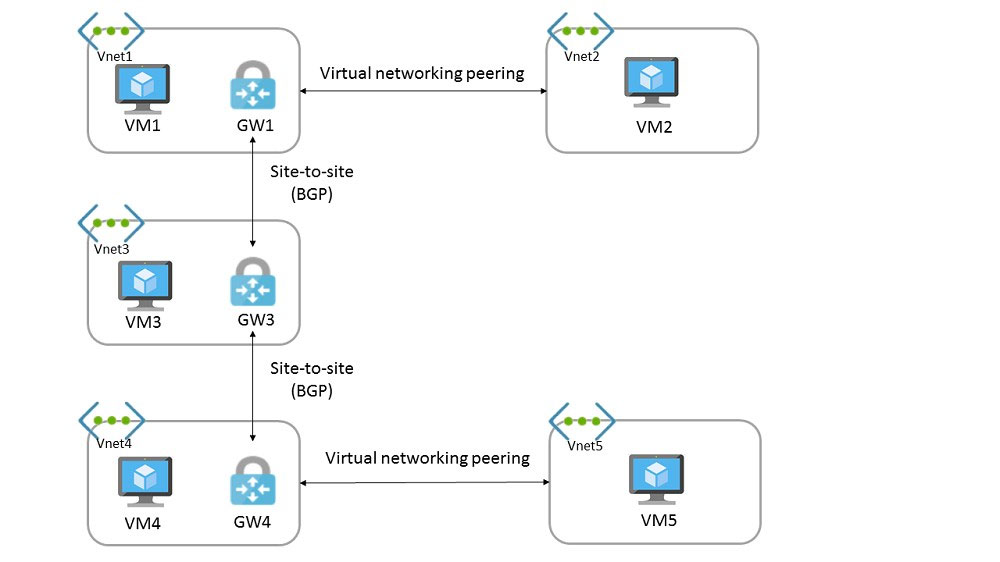
You have virtual network peering between Vnet1 and Vnet2. You have virtual network peering between Vnet4 and Vnet5. The virtual network peering is configured as shown in the following table.

For each of the following statements, select Yes if the statement is true. Otherwise, select No.
Hot Area:
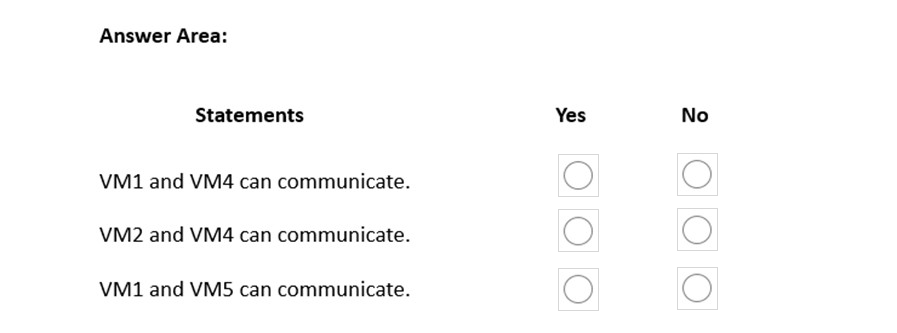
You have the Azure environment shown in the exhibit.

You have virtual network peering between Vnet1 and Vnet2. You have virtual network peering between Vnet4 and Vnet5. The virtual network peering is configured as shown in the following table.

For each of the following statements, select Yes if the statement is true. Otherwise, select No.
Hot Area:

Correct Answer:
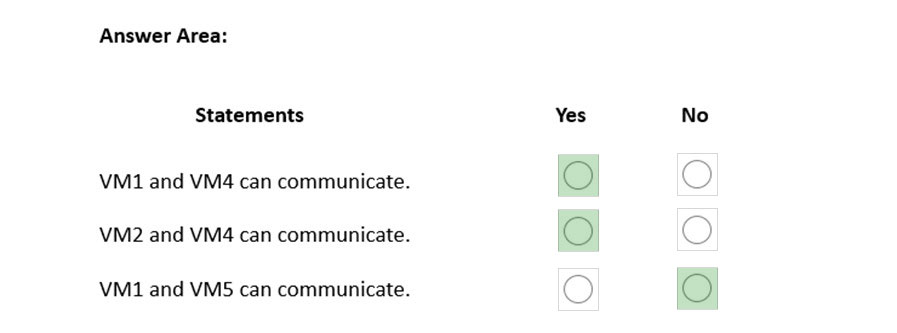
Box 1: Yes -
Virtual network peering seamlessly connects two Azure virtual networks, merging the two virtual networks into one for connectivity purposes. Gateway transit is a peering property that lets one virtual network use the VPN gateway in the peered virtual network for cross-premises or VNet-to-VNet connectivity.
The following diagram shows how gateway transit works with virtual network peering.
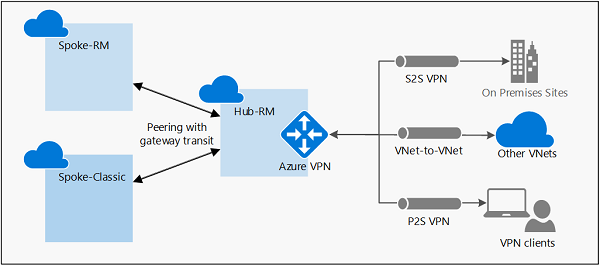
In the diagram, gateway transit allows the peered virtual networks to use the Azure VPN gateway in Hub-RM. Connectivity available on the VPN gateway, including S2S, P2S, and VNet-to-VNet connections, applies to all three virtual networks.
In hub-and-spoke network architecture, gateway transit allows spoke virtual networks to share the VPN gateway in the hub, instead of deploying VPN gateways in every spoke virtual network.
Box 2: Yes -
VM2 uses the remote gateway GW1 to reach VM4.
Box 3: No -
VM2 can reach VM4 through GW1, but not VM5 as VNEt1 does not use remote Gateways.
Reference:
https://docs.microsoft.com/en-us/azure/vpn-gateway/vpn-gateway-peering-gateway-transit https://docs.microsoft.com/en-us/azure/virtual-network/virtual-network-troubleshoot-peering-issues

Box 1: Yes -
Virtual network peering seamlessly connects two Azure virtual networks, merging the two virtual networks into one for connectivity purposes. Gateway transit is a peering property that lets one virtual network use the VPN gateway in the peered virtual network for cross-premises or VNet-to-VNet connectivity.
The following diagram shows how gateway transit works with virtual network peering.

In the diagram, gateway transit allows the peered virtual networks to use the Azure VPN gateway in Hub-RM. Connectivity available on the VPN gateway, including S2S, P2S, and VNet-to-VNet connections, applies to all three virtual networks.
In hub-and-spoke network architecture, gateway transit allows spoke virtual networks to share the VPN gateway in the hub, instead of deploying VPN gateways in every spoke virtual network.
Box 2: Yes -
VM2 uses the remote gateway GW1 to reach VM4.
Box 3: No -
VM2 can reach VM4 through GW1, but not VM5 as VNEt1 does not use remote Gateways.
Reference:
https://docs.microsoft.com/en-us/azure/vpn-gateway/vpn-gateway-peering-gateway-transit https://docs.microsoft.com/en-us/azure/virtual-network/virtual-network-troubleshoot-peering-issues
send
light_mode
delete
Question #12
HOTSPOT -
You have on-premises datacenters in New York and Seattle.
You have an Azure subscription that contains the ExpressRoute circuits shown in the following table.

You need to ensure that all the data sent between the datacenters is routed via the ExpressRoute circuits. The solution must minimize costs.
How should you configure the network? To answer, select the appropriate options in the answer area.
NOTE: Each correct selection is worth one point.
Hot Area:
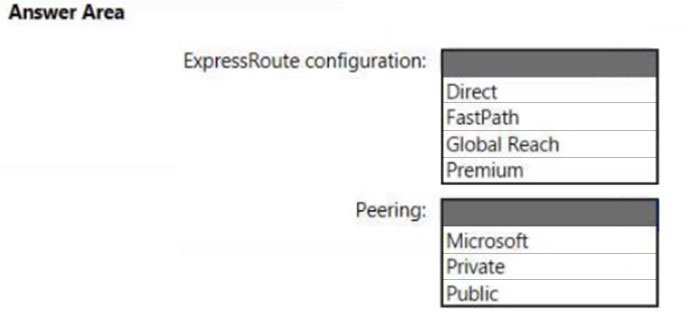
You have on-premises datacenters in New York and Seattle.
You have an Azure subscription that contains the ExpressRoute circuits shown in the following table.

You need to ensure that all the data sent between the datacenters is routed via the ExpressRoute circuits. The solution must minimize costs.
How should you configure the network? To answer, select the appropriate options in the answer area.
NOTE: Each correct selection is worth one point.
Hot Area:

Correct Answer:
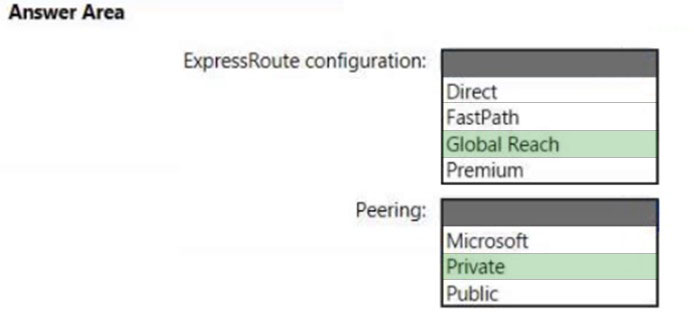
Box 1: Global Reach -
ExpressRoute Global Reach is the service where if you have two datacenters, which are located at different geo-locations and both are connected to Microsoft
Azure via Express Route then these two datacenters can also connect to each other securely via Microsoft's backbone.
Incorrect:
FastPath is designed to improve the data path performance between your on-premises network and your virtual network. When enabled, FastPath sends network traffic directly to virtual machines in the virtual network, bypassing the gateway.
Box 2: Private -
With ExpressRoute Global Reach, you can link ExpressRoute circuits together to make a private network between your on-premises networks.
Reference:
https://docs.microsoft.com/en-us/azure/expressroute/expressroute-global-reach

Box 1: Global Reach -
ExpressRoute Global Reach is the service where if you have two datacenters, which are located at different geo-locations and both are connected to Microsoft
Azure via Express Route then these two datacenters can also connect to each other securely via Microsoft's backbone.
Incorrect:
FastPath is designed to improve the data path performance between your on-premises network and your virtual network. When enabled, FastPath sends network traffic directly to virtual machines in the virtual network, bypassing the gateway.
Box 2: Private -
With ExpressRoute Global Reach, you can link ExpressRoute circuits together to make a private network between your on-premises networks.
Reference:
https://docs.microsoft.com/en-us/azure/expressroute/expressroute-global-reach
send
light_mode
delete
Question #13
You have an Azure virtual network named Vnet1 and an on-premises network. The on-premises network has policy-based VPN devices.
In Vnet1, you deploy a virtual network gateway named GW1 that uses a SKU of VpnGw1 and is route-based.
You have a Site-to-Site VPN connection for GW1 as shown in the following exhibit.
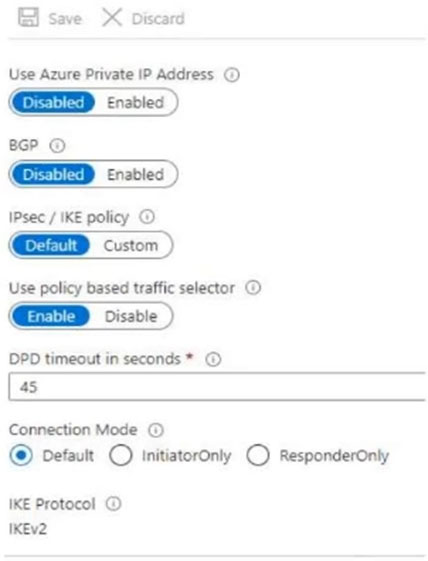
You need to ensure that the on-premises network can connect to the route-based GW1.
What should you do before you create the connection?
In Vnet1, you deploy a virtual network gateway named GW1 that uses a SKU of VpnGw1 and is route-based.
You have a Site-to-Site VPN connection for GW1 as shown in the following exhibit.

You need to ensure that the on-premises network can connect to the route-based GW1.
What should you do before you create the connection?
- ASet Connection Mode to ResponderOnly.
- BSet BGP to Enabled.
- CSet Use Azure Private IP Address to Enabled.
- DSet IPsec / IKE policy to Custom.Most Voted
send
light_mode
delete
Question #14
Note: This question is part of a series of questions that present the same scenario. Each question in the series contains a unique solution that might meet the stated goals. Some question sets might have more than one correct solution, while others might not have a correct solution.
After you answer a question in this section, you will NOT be able to return to it. As a result, these questions will not appear in the review screen.
You have two Azure virtual networks named Vnet1 and Vnet2.
You have a Windows 10 device named Client1 that connects to Vnet1 by using a Point-to-Site (P2S) IKEv2 VPN.
You implement virtual network peering between Vnet1 and Vnet2. Vnet1 allows gateway transit. Vnet2 can use the remote gateway.
You discover that Client1 cannot communicate with Vnet2.
You need to ensure that Client1 can communicate with Vnet2.
Solution: You reset the gateway of Vnet1.
Does this meet the goal?
After you answer a question in this section, you will NOT be able to return to it. As a result, these questions will not appear in the review screen.
You have two Azure virtual networks named Vnet1 and Vnet2.
You have a Windows 10 device named Client1 that connects to Vnet1 by using a Point-to-Site (P2S) IKEv2 VPN.
You implement virtual network peering between Vnet1 and Vnet2. Vnet1 allows gateway transit. Vnet2 can use the remote gateway.
You discover that Client1 cannot communicate with Vnet2.
You need to ensure that Client1 can communicate with Vnet2.
Solution: You reset the gateway of Vnet1.
Does this meet the goal?
- AYes
- BNoMost Voted
Correct Answer:
B
The VPN client must be downloaded again if any changes are made to VNet peering or the network topology.
Reference:
https://docs.microsoft.com/en-us/azure/vpn-gateway/vpn-gateway-about-point-to-site-routing
B
The VPN client must be downloaded again if any changes are made to VNet peering or the network topology.
Reference:
https://docs.microsoft.com/en-us/azure/vpn-gateway/vpn-gateway-about-point-to-site-routing
send
light_mode
delete
Question #15
Note: This question is part of a series of questions that present the same scenario. Each question in the series contains a unique solution that might meet the stated goals. Some question sets might have more than one correct solution, while others might not have a correct solution.
After you answer a question in this section, you will NOT be able to return to it. As a result, these questions will not appear in the review screen.
You have two Azure virtual networks named Vnet1 and Vnet2.
You have a Windows 10 device named Client1 that connects to Vnet1 by using a Point-to-Site (P2S) IKEv2 VPN.
You implement virtual network peering between Vnet1 and Vnet2. Vnet1 allows gateway transit. Vnet2 can use the remote gateway.
You discover that Client1 cannot communicate with Vnet2.
You need to ensure that Client1 can communicate with Vnet2.
Solution: You enable BGP on the gateway of Vnet1.
Does this meet the goal?
After you answer a question in this section, you will NOT be able to return to it. As a result, these questions will not appear in the review screen.
You have two Azure virtual networks named Vnet1 and Vnet2.
You have a Windows 10 device named Client1 that connects to Vnet1 by using a Point-to-Site (P2S) IKEv2 VPN.
You implement virtual network peering between Vnet1 and Vnet2. Vnet1 allows gateway transit. Vnet2 can use the remote gateway.
You discover that Client1 cannot communicate with Vnet2.
You need to ensure that Client1 can communicate with Vnet2.
Solution: You enable BGP on the gateway of Vnet1.
Does this meet the goal?
- AYes
- BNoMost Voted
Correct Answer:
B
The VPN client must be downloaded again if any changes are made to VNet peering or the network topology.
Reference:
https://docs.microsoft.com/en-us/azure/vpn-gateway/vpn-gateway-about-point-to-site-routing
B
The VPN client must be downloaded again if any changes are made to VNet peering or the network topology.
Reference:
https://docs.microsoft.com/en-us/azure/vpn-gateway/vpn-gateway-about-point-to-site-routing
send
light_mode
delete
Question #16
HOTSPOT -
You have the Azure environment shown in the following exhibit.
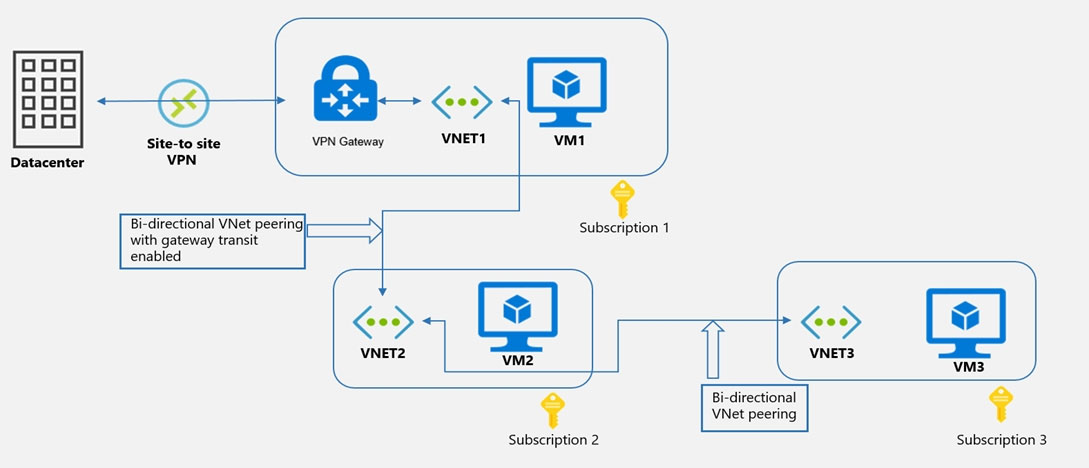
Use the drop-down menus to select the answer choice that completes each statement based on the information presented in the graphic.
NOTE: Each correct selection is worth one point.
Hot Area:
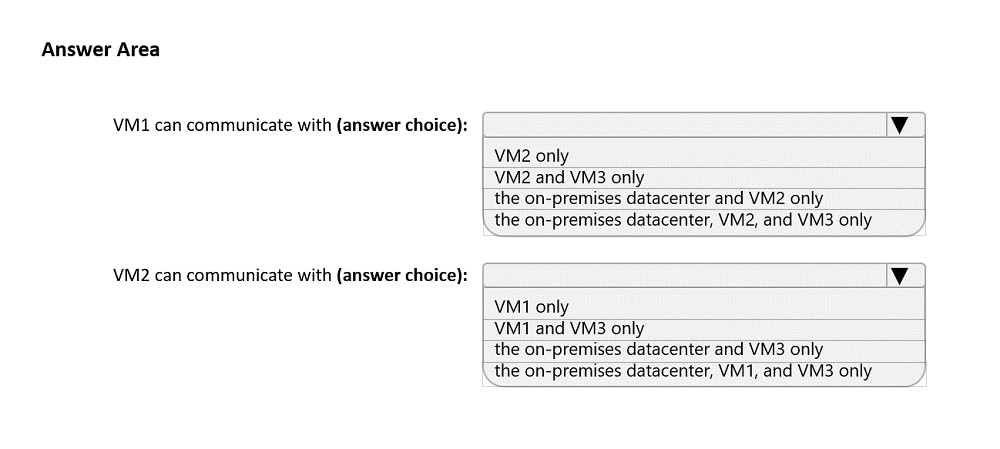
You have the Azure environment shown in the following exhibit.

Use the drop-down menus to select the answer choice that completes each statement based on the information presented in the graphic.
NOTE: Each correct selection is worth one point.
Hot Area:

Correct Answer:
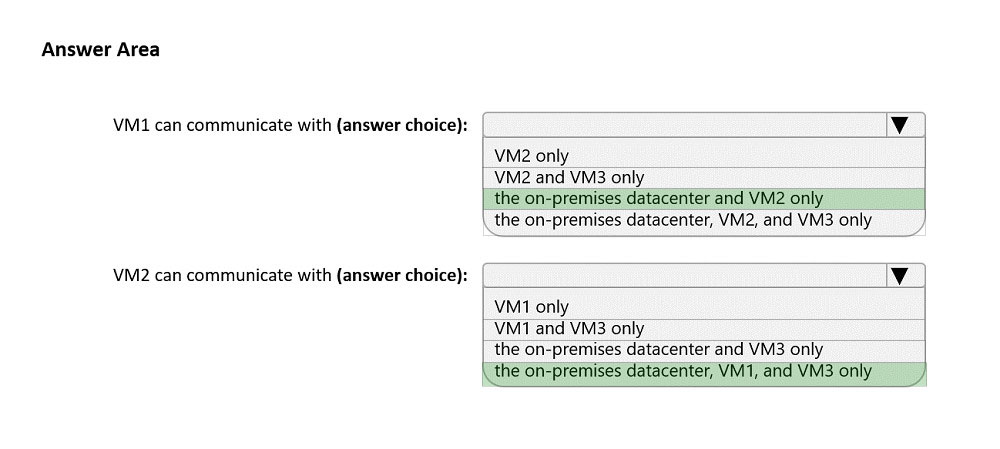
Reference:
https://docs.microsoft.com/en-us/azure/vpn-gateway/vpn-gateway-peering-gateway-transit?toc=/azure/virtual-network/toc.json

Reference:
https://docs.microsoft.com/en-us/azure/vpn-gateway/vpn-gateway-peering-gateway-transit?toc=/azure/virtual-network/toc.json
send
light_mode
delete
Question #17
You plan to deploy Azure virtual network.
You need to design the subnets.
Which three types of resources require a dedicated subnet? Each correct answer presents a complete solution.
NOTE: Each correct selection is worth one point.
You need to design the subnets.
Which three types of resources require a dedicated subnet? Each correct answer presents a complete solution.
NOTE: Each correct selection is worth one point.
- AAzure BastionMost Voted
- BAzure Active Directory Domain Services (Azure AD DS)
- CAzure Private Link
- DAzure Application Gateway v2Most Voted
- EVPN gatewayMost Voted
Correct Answer:
ADE
Reference:
https://docs.microsoft.com/en-us/azure/virtual-network/virtual-network-for-azure-services
ADE
Reference:
https://docs.microsoft.com/en-us/azure/virtual-network/virtual-network-for-azure-services
send
light_mode
delete
Question #18
HOTSPOT -
You have an Azure private DNS zone named contoso.com that is linked to the virtual networks shown in the following table.

The links have auto registration enabled.
You create the virtual machines shown in the following table.
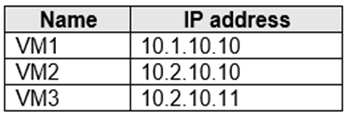
You manually add the following entry to the contoso.com zone:
✑ Name: VM1
IP address: 10.1.10.9 -

For each of the following statements, select Yes if the statement is true. Otherwise, select No.
NOTE: Each correct selection is worth one point.
Hot Area:

You have an Azure private DNS zone named contoso.com that is linked to the virtual networks shown in the following table.

The links have auto registration enabled.
You create the virtual machines shown in the following table.

You manually add the following entry to the contoso.com zone:
✑ Name: VM1
IP address: 10.1.10.9 -

For each of the following statements, select Yes if the statement is true. Otherwise, select No.
NOTE: Each correct selection is worth one point.
Hot Area:

Correct Answer:

Box 1: No -
The manual DNS record will overwrite the auto-registered DNS record so VM1 will resolve to 10.1.10.9.
Box 2: No -
The DNS record for VM1 is now a manually created record rather than an auto-registered record. Only auto-registered DNS records are deleted when a VM is deleted.
Box 3: No -
This answer depends on how the IP address is changed. To change the IP address of a VM manually, you would need to select 'Static' as the IP address assignment. In this case, the DNS record will not be updated because only DHCP assigned IP addresses are auto-registered.
Reference:
https://docs.microsoft.com/en-us/azure/dns/dns-faq-private

Box 1: No -
The manual DNS record will overwrite the auto-registered DNS record so VM1 will resolve to 10.1.10.9.
Box 2: No -
The DNS record for VM1 is now a manually created record rather than an auto-registered record. Only auto-registered DNS records are deleted when a VM is deleted.
Box 3: No -
This answer depends on how the IP address is changed. To change the IP address of a VM manually, you would need to select 'Static' as the IP address assignment. In this case, the DNS record will not be updated because only DHCP assigned IP addresses are auto-registered.
Reference:
https://docs.microsoft.com/en-us/azure/dns/dns-faq-private
send
light_mode
delete
Question #19
HOTSPOT -
Your company has an Azure virtual network named Vnet1 that uses an IP address space of 192.168.0.0/20. Vnet1 contains a subnet named Subnet1 that uses an
IP address space of 192.168.0.0/24.
You create an IPv6 address range to Vnet1 by using a CIDR suffix of /48.
You need to enable the virtual machines on Subnet1 to communicate with each other by using IPv6 addresses assigned by the company. The solution must minimize the number of additional IPv4 addresses.
What should you do? To answer, select the appropriate options in the answer area.
NOTE: Each correct selection is worth one point.
Hot Area:

Your company has an Azure virtual network named Vnet1 that uses an IP address space of 192.168.0.0/20. Vnet1 contains a subnet named Subnet1 that uses an
IP address space of 192.168.0.0/24.
You create an IPv6 address range to Vnet1 by using a CIDR suffix of /48.
You need to enable the virtual machines on Subnet1 to communicate with each other by using IPv6 addresses assigned by the company. The solution must minimize the number of additional IPv4 addresses.
What should you do? To answer, select the appropriate options in the answer area.
NOTE: Each correct selection is worth one point.
Hot Area:

Correct Answer:
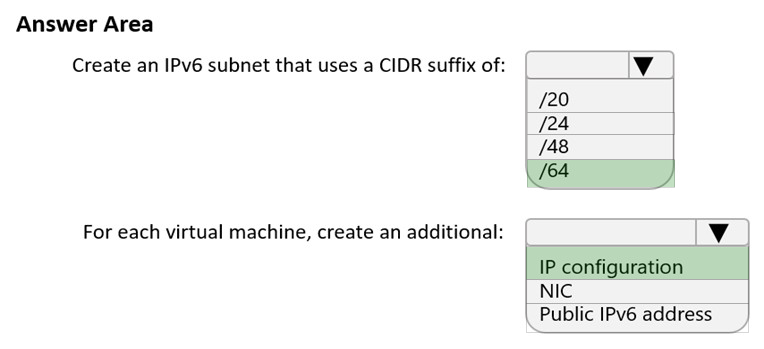
Reference:
https://docs.microsoft.com/en-us/azure/virtual-network/ipv6-overview https://docs.microsoft.com/en-us/azure/virtual-network/ipv6-add-to-existing-vnet-powershell

Reference:
https://docs.microsoft.com/en-us/azure/virtual-network/ipv6-overview https://docs.microsoft.com/en-us/azure/virtual-network/ipv6-add-to-existing-vnet-powershell
send
light_mode
delete
Question #20
HOTSPOT -
You plan to deploy Azure Virtual WAN.
You need to deploy a virtual WAN hub that meets the following requirements:
✑ Supports 10 sites that will connect to the virtual WAN hub by using a Site-to-Site VPN connection
✑ Supports 8 Gbps of ExpressRoute traffic
✑ Minimizes costs
What should you configure? To answer, select the appropriate options in the answer area.
NOTE: Each correct selection is worth one point.
Hot Area:
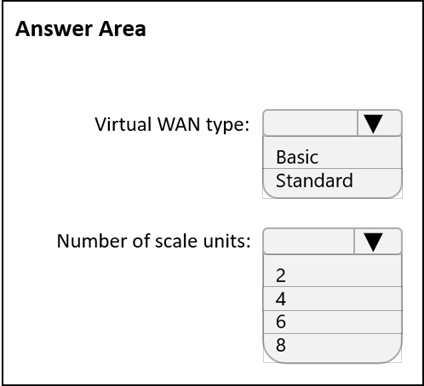
You plan to deploy Azure Virtual WAN.
You need to deploy a virtual WAN hub that meets the following requirements:
✑ Supports 10 sites that will connect to the virtual WAN hub by using a Site-to-Site VPN connection
✑ Supports 8 Gbps of ExpressRoute traffic
✑ Minimizes costs
What should you configure? To answer, select the appropriate options in the answer area.
NOTE: Each correct selection is worth one point.
Hot Area:

Correct Answer:
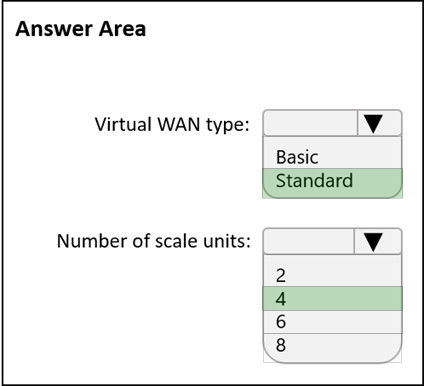
Reference:
https://docs.microsoft.com/en-us/azure/virtual-wan/virtual-wan-about

Reference:
https://docs.microsoft.com/en-us/azure/virtual-wan/virtual-wan-about
send
light_mode
delete
All Pages
